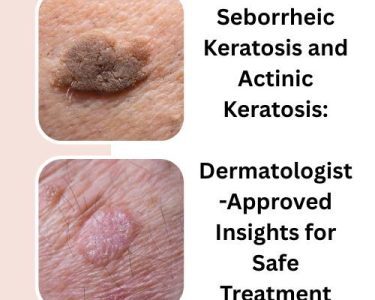Seborrheic keratosis is one of the most common non-cancerous skin growths, often appearing as rough, wart-like patches or brown spots on the face, chest, or back. Although these lesions are harmless, many people find them unattractive and seek safe ways to remove or reduce their appearance. One natural remedy that has gained popularity for this purpose is castor oil.
For centuries, castor oil has been valued for its powerful healing and anti-inflammatory properties. Today, it is being rediscovered as a potential Natural Treatment for Seborrheic Keratosis for a wide range of skin conditions—including seborrheic keratosis. In this article, we will explore how castor oil for seborrheic keratosis works, its benefits, application methods, scientific evidence, and precautions to keep in mind.
Understanding Seborrheic Keratosis
Before diving into treatment options, it’s essential to understand what seborrheic keratosis is and how it forms.
What Is Seborrheic Keratosis?
Seborrheic keratosis (often abbreviated as SK) is a benign (non-cancerous) skin growth that develops due to an overproduction of skin cells. It typically appears in middle-aged and older adults, though it can occur at any age. The growths can vary in color—from light tan to dark brown or even black—and often have a waxy, scaly, or slightly raised surface.
Related Article: Can You Really Treat Seborrheic Keratosis with Supplements? Read This First!
Causes and Risk Factors
The exact cause of seborrheic keratosis remains unclear, but several factors are believed to contribute:
- Genetics: A family history of seborrheic keratosis increases the likelihood of developing the condition.
- Age: It commonly appears with aging as cell turnover slows down.
- Sun Exposure: Chronic exposure to UV radiation may accelerate skin changes and lesion formation.
- Hormonal Changes: Hormones might play a role, especially in women during pregnancy or menopause.
- Skin Friction: Repeated friction or irritation on certain skin areas can sometimes trigger lesions.
Although seborrheic keratosis is harmless, it can be mistaken for more serious conditions like melanoma, so medical evaluation is always advised for any new or changing skin growth.
Traditional Treatments for Seborrheic Keratosis
Medical treatments for seborrheic keratosis are typically cosmetic and include:
- Cryotherapy: Freezing the lesion with liquid nitrogen.
- Curettage: Scraping the growth off under local anesthesia.
- Electrocautery: Burning the growth using electric current.
- Laser Therapy: Using focused light beams to vaporize the lesion.
- Topical Treatments: Prescribed creams containing hydrogen peroxide, urea, or alpha hydroxy acids.
While these procedures are effective, they can be costly, painful, and sometimes leave behind scars or pigmentation changes. That’s why many people are turning toward natural alternatives like castor oil—a gentler and more affordable option.
What Is Castor Oil?
Castor oil is a thick, pale yellow oil derived from the seeds of the Ricinus communis plant. It has been used for thousands of years in traditional medicine for its healing, anti-inflammatory, and antibacterial properties.
The oil’s main active component is ricinoleic acid, a unique fatty acid known for its skin-soothing and cell-regenerating effects. These qualities make it a promising natural option for managing various skin problems—including seborrheic keratosis.
How Castor Oil Works for Seborrheic Keratosis
So, how does castor oil help in reducing or removing seborrheic keratosis growths? While there is limited direct scientific research on this specific use, several mechanisms can explain its potential benefits.
Related Article: Natural Remedies for Seborrheic Keratosis at Home
1. Moisturizing and Softening Effects
Seborrheic keratosis lesions often have a thick, crusty surface. Castor oil’s deep moisturizing action can help soften the outer layers of the skin, making the growth less rough and more pliable over time. This helps the lesion gradually fade or peel off naturally.
2. Anti-Inflammatory Properties
Ricinoleic acid in castor oil has strong anti-inflammatory effects, which may help reduce irritation, redness, or swelling around the lesion. This can make the affected skin appear smoother and calmer.
3. Skin Cell Regeneration
Castor oil promotes the regeneration of healthy skin tissue. Regular application may support the natural turnover of cells, encouraging the shedding of dead or damaged skin layers, which could help diminish seborrheic keratosis spots.
4. Antioxidant and Antimicrobial Benefits
Castor oil contains vitamin E, omega fatty acids, and other antioxidants that help protect skin cells from oxidative stress—a factor that may contribute to abnormal skin growths. Additionally, its mild antimicrobial action can prevent secondary infections, especially if the lesion becomes irritated.
Related Article:10 Natural Remedies for Seborrheic Keratosis
Benefits of Using Castor Oil for Seborrheic Keratosis
People who use castor oil seborrheic keratosis treatments often report several benefits beyond lesion reduction:
- Completely Natural: Castor oil is plant-based and free from harsh chemicals or synthetic ingredients.
- Affordable and Accessible: A small bottle can last for months, making it a cost-effective solution.
- Non-Invasive: Unlike cryotherapy or laser treatment, there’s no need for surgery, pain, or recovery time.
- Hydrating: Castor oil helps improve the overall texture and hydration of your skin.
- Low Risk of Scarring: When used properly, it rarely causes irritation or scarring.
How to Use Castor Oil for Seborrheic Keratosis
To achieve the best results, it’s important to use castor oil correctly. Here’s a step-by-step guide to applying it safely.
1. Choose the Right Type of Castor Oil
Look for cold-pressed, hexane-free, organic castor oil. This ensures purity and preserves the natural nutrients of the oil.
2. Clean the Affected Area
Wash the area gently with mild soap and warm water. Pat dry completely before applying the oil.
3. Apply the Oil
- Take a few drops of castor oil on your fingertips or a cotton swab.
- Gently massage it onto the seborrheic keratosis lesion using circular motions for a few minutes.
- Allow the oil to absorb fully into the skin.
4. Use with Baking Soda (Optional)
Some people enhance the effect by mixing castor oil with baking soda to create a mild paste. This combination can help exfoliate the lesion naturally.
Instructions:
- Mix 1 teaspoon of baking soda with enough castor oil to form a paste.
- Apply the paste to the affected area and cover it with a small bandage.
- Leave it on overnight and rinse with warm water in the morning.
- Repeat daily until you see improvement.
5. Frequency of Use
Consistency is key. Apply the oil once or twice daily for several weeks or months, depending on the size and age of the lesion. Visible results may take time, as natural remedies work gradually.
Possible Side Effects and Precautions
While castor oil for seborrheic keratosis is generally considered safe, it’s still important to take precautions:
- Patch Test: Apply a small amount of oil on your forearm first to test for allergic reactions.
- Avoid Open Wounds: Do not apply the oil to broken, bleeding, or infected lesions.
- Consult a Dermatologist: If a lesion changes color, bleeds, or grows rapidly, seek medical advice.
- Avoid Eye Area: Do not apply castor oil near the eyes or eyelids.
Although rare, some people may experience mild irritation or redness after application. If this occurs, discontinue use and switch to gentler oils like coconut or olive oil.
Scientific Evidence Supporting Castor Oil’s Skin Benefits
While specific clinical studies on castor oil seborrheic keratosis are limited, scientific research supports its general skin-healing potential.
- A 2012 study published in Pharmacognosy Research highlighted ricinoleic acid’s anti-inflammatory and antimicrobial effects, validating its use for skin health.
- Research in the Journal of Ethnopharmacology demonstrated castor oil’s wound-healing properties, showing it promotes tissue regeneration and reduces inflammation.
- Dermatologists acknowledge that the hydrating and antioxidant-rich nature of castor oil can support the skin barrier and slow down age-related changes—factors relevant to seborrheic keratosis.
Related Article: Treatment of Seborrheic Keratosis Symptoms
While these studies don’t prove castor oil can remove seborrheic keratosis entirely, they support its role as a natural supportive therapy that can improve skin condition and appearance.
Other Natural Remedies to Combine with Castor Oil
For best results, some people combine castor oil with other natural ingredients known for their skin-healing benefits:
1. Apple Cider Vinegar
Its natural acids may help exfoliate dead skin cells and lighten pigmentation.
2. Tea Tree Oil
An antiseptic and antimicrobial oil that can help prevent irritation or infection.
3. Aloe Vera Gel
Soothes and hydrates the skin, enhancing the moisturizing effect of castor oil.
4. Vitamin E Oil
Rich in antioxidants, it can support cell renewal and reduce roughness.
When combining these remedies, use them cautiously and always dilute essential oils properly to avoid irritation.
Lifestyle Tips to Support Skin Health
In addition to using castor oil for seborrheic keratosis, maintaining overall skin health can help prevent new lesions from developing.
- Protect from Sun Exposure: Use sunscreen daily to minimize UV damage.
- Stay Hydrated: Drink enough water to maintain skin elasticity.
- Eat a Balanced Diet: Include foods rich in antioxidants, vitamins A, C, and E.
- Avoid Scratching: Picking or scratching lesions can cause irritation or infection.
- Regular Check-Ups: Have a dermatologist check your skin yearly, especially if you have many growths.
What to Expect: Patience and Consistency
Natural remedies like castor oil work slowly but effectively over time. You might notice that the seborrheic keratosis lesion becomes softer, lighter, and eventually flakes off after consistent use for several weeks or months.
However, results vary depending on individual skin type, lesion size, and consistency of application. Always remember that natural treatment requires patience and persistence.
Related Article: Seborrheic Keratosis – Melanoma Skin Cancer
When to Seek Medical Help
Although seborrheic keratosis is harmless, it can sometimes resemble malignant melanoma, a type of skin cancer. Consult a dermatologist if you notice:
- Rapid growth or spreading lesions
- Bleeding or crusting
- Sudden color changes
- Pain, itching, or inflammation
Professional diagnosis ensures you’re not mistaking something more serious for a benign condition.
Conclusion
Seborrheic keratosis is a common yet harmless skin condition that can affect confidence and appearance. While conventional treatments are effective, they can be invasive or expensive. For those seeking a gentle, cost-effective, and natural approach, castor oil for seborrheic keratosis offers a promising alternative.
With its powerful moisturizing, anti-inflammatory, and regenerative properties, castor oil can help soften lesions, improve skin texture, and support the body’s natural healing process. Though results take time, many people find that consistent application helps reduce the visibility and roughness of seborrheic keratosis over time.
Remember, while castor oil seborrheic keratosis treatment is safe for most people, it’s best to use it under the guidance of a dermatologist—especially if you have sensitive skin or multiple lesions.
Nature often provides effective solutions where modern treatments fall short, and castor oil stands out as a timeless remedy that continues to prove its worth in modern skincare.




